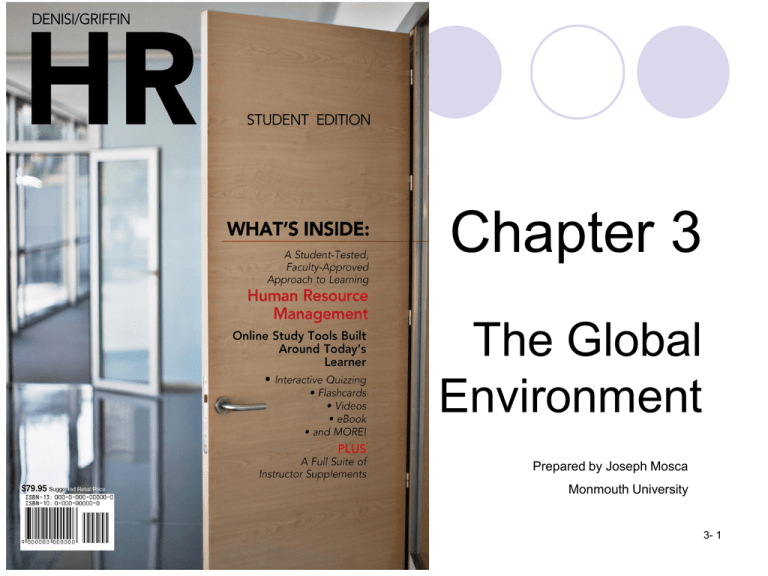
Chapter 3
The Global
Environment
Prepared by Joseph Mosca
Monmouth University
Copyright © 2012 by Cengage Learning. All rights reserved.
3- 1
Learning Objectives
1. Describe the growth of international
business.
2. Identify and discuss global issues in
international human resource management.
3. Discuss the human resource management
function in international business.
4. Identify and discuss domestic issues in
international human resource management.
5. Describe the issues involved in managing
international transfers and assignments.
6. Summarize the issues in international labor
relations.
Copyright © 2012 by Cengage Learning. All rights reserved.
3- 2
The Growth of International Business
During the 1950s, the U.S.
was the dominant force.
In the 1960s, the U.S. was
challenged by other countries.
The U.S. market downturn in 2002 had
effects on world markets.
Copyright © 2012 by Cengage Learning. All rights reserved.
3- 3
International HR Strategy
The ethnocentric staffing model:
Primarily uses parent country nationals to
staff higher level foreign positions.
Is based on the assumption that homebased perspectives take precedence over
local perspectives and issues positions to
parent country nationals.
Copyright © 2012 by Cengage Learning. All rights reserved.
3- 4
What Are the Staffing Considerations?
Polycentric staffing model:
calls for heavy use of
host-country nationals throughout
the organization.
It puts parent-country nationals,
host-country nationals, and thirdcountry nationals all in the same
category, with the firm attempting
always to hire
the best person available
for a position.
Copyright © 2012 by Cengage Learning. All rights reserved.
3- 5
Understanding the Cultural
Environment
Copyright © 2012 by Cengage Learning. All rights reserved.
A country’s culture can be
defined as the set of
values, symbols, beliefs,
and languages that guide
behavior of the people
within that culture.
Managers in an
international business
need to be aware of
cultural nuances and
must be especially
cognizant of the role of
cultural differences and
similarities in workers
3- 6
from different cultures.
Specific Human Resource Issues in
International Business
Exporting is the process of making a
product in the firm’s domestic marketplace
and then selling it in another country.
Licensing involves one company granting
its permission to another company in a
foreign country to manufacture and/or
market the first company’s products in the
second company’s local market.
Copyright © 2012 by Cengage Learning. All rights reserved.
3- 7
Specific Human Resource Issues in
International Business (cont’d)
Direct Investment occurs when a firm
headquartered in one country builds or
purchases operating facilities or
subsidiaries in a foreign country.
In a Joint Venture or Strategic Alliance
two or more firms cooperate in the
ownership and/or management of an
operation on an equity basis.
Copyright © 2012 by Cengage Learning. All rights reserved.
3- 8
Managing International Transfers and
Assignments
Expatriates are employees who are sent
by a firm to work in another country and
may be either parent-country nationals or
third-country nationals.
Key areas of importance are:
Selection
Training
Compensation
Copyright © 2012 by Cengage Learning. All rights reserved.
3- 9
Local Compensation Issues
In the US compensation assessment is
based on an individual’s performance.
However, in other countries such as
Japan, the emphasis is based more on
group work.
Copyright © 2012 by Cengage Learning. All rights reserved.
3- 10
Hardship Premium
A hardship premium
(also called a foreignservice premium) is
an additional financial
incentive offered to
an individual to entice
them to accept a less
attractive international
assignment
Copyright © 2012 by Cengage Learning. All rights reserved.
3- 11





